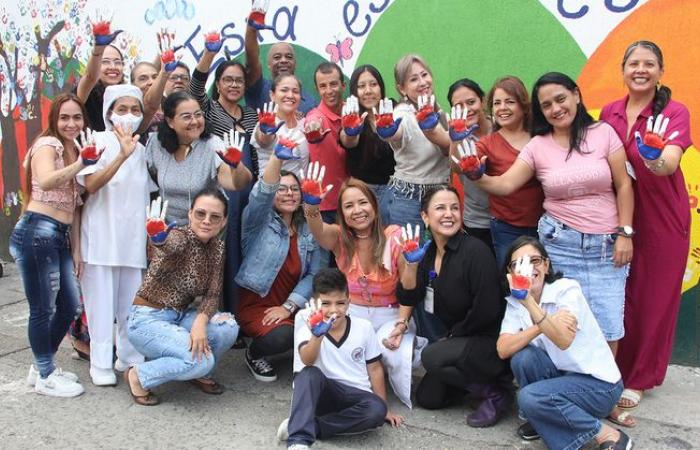- A natural sciences teacher along with her fourth grade students lead the school garden that promotes self-sufficiency.
- A mural on Seventh Street sealed the teamwork between members of the educational community to recover a school space.
Santiago de Cali, June 28, 2024
The union between the members of the school community of the La Gran Colombia campus, attached to the Official Educational Institution Liceo Departamental, located in the traditional Alameda neighborhood, managed to recover the façade that was in disrepair by building a school garden and beautifying the area that borders Seventh Street, south of Cali.
Sara Serna, primary school teacher, explained that “the garden was born from a question I asked in class three years ago and it was “where do fruits and vegetables come from?” The children responded that they were coming from the supermarket. Then, I kept asking them where they came from before arriving at the supermarket and they couldn’t answer me. That told me that they did not have clarity regarding the agricultural process.”
You may be interested in: This is how the educational infrastructure works led by the National Government are progressing
In this way, the natural sciences teacher decided to take advantage of a space at the back of the school building that was abandoned and full of rubble to harvest her love for agriculture and thus, she began to dream of a school garden that, three years later, It became a plantation of papaya, spinach, thyme, banana, basil, oregano, tomato, chili, yucca, and pumpkin accompanied by pollinating plants. The school farm is the result of her joint work with her fourth grade students and parents.
“I invited the mothers and fathers of my students to tell them about the idea of the school agroecological garden. I told them that it was required to chop, lift dead rock, and gradually replace it with fertilized land, which required time, labor, and costs. They liked the project, so we adapted the space and began to plant little by little, water was channeled, our first crops were flooded but in the end we achieved it,” says Professor Sara.
The United Nations Sustainable Development Goals (SDGs), specifically Zero Hunger, was one of the topics with which this learning process was linked for the educational community, which in turn allowed students to become familiar with sustainability, ensuring some food at home. “Many children with very low economic resources study here, so whenever there is a harvest, it is distributed among them. And that is how that initial question I asked in class three years ago was materialized and resolved through the experience of the orchard children who, year after year, become empowered, know the processes and continue learning.”
Added to this great effort was the desire to recover the façade of Seventh Street that was abandoned, a situation that called upon the primary school teachers of La Gran Colombia to beautify it by adapting the wall on which a colorful mural was painted. as a symbol that seals the sense of belonging of the members of the educational community.
“Previously, when we went out with the children to the garden, given that it borders the street, we saw many street dwellers who were sometimes using drugs, other times we smelled human feces that were resting on the platform, so when they saw the children, began to run towards the back wall. After a while, we made the decision to enable the door on Seventh Street so that, with the flow of students and parents, a process of appropriation of the pedagogical spaces would begin and, again, with the help of those same parents. family that participated in the construction of the garden, we decided to paint a mural and beautify our headquarters,” explained the teacher.
This is how, through different activities such as jean day and the sale of suckling pig, the financial resources were raised for the purchase of stucco, paint and the labor of the mural where the painted footprints of the hands of school principals, teachers, administrators, mothers, fathers and students rest. They have been part of this process closely linked to what Cali is currently experiencing, a city that champions the recovery and transformation of the district, a city where the world has its eyes on thanks to the strength and resilience of its inhabitants, which made it worthy of being the meeting place for COP16, the most important international conference in the world on biodiversity that will take place between October 21 and November 1, 2024.
You may be interested in: Festival season has begun in Cali! Get ready to enjoy all our cultural wealth
Silvia C. Ortiz Burgos
Communications from the Department of Education of Cali






